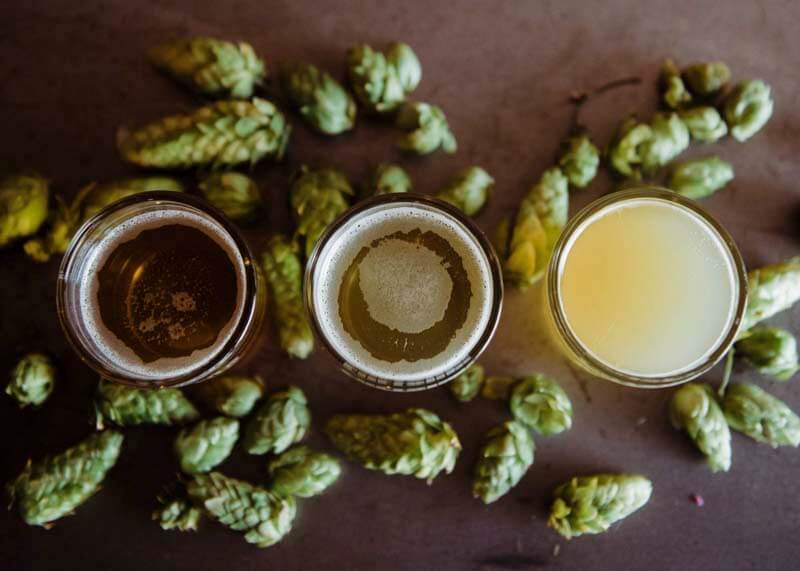
We recently put together a guide for all of the hops grown in America and another for those found in the Southern Hemisphere. But while hops in the United States, Australia, New Zealand, and South Africa are fairly new, we can’t forget about noble hops, classic European varieties that have been cultivated for hundreds of years.
Found mostly in Germany and the Czech Republic, the four noble hop varieties—Hallertauer Mittelfrüher, Tettnanger (sometimes referred to as Tettnang), Spalt (sometimes called Spalter), and Saaz—dominated hop production around the world for many years.
In fact, Germany held the record for the largest amount of hop acreage in the world, only overtaken by the United States in 2015, according to The Hop Growers of America 2021 Statistical Report. In 2021, the U.S. harvested the largest hop acreage at a little over 61k acres, followed by Germany at 51k, and the Czech Republic at 12.2k.
Even though “sexier” New World varieties such as Citra, Cascade, and even Nectaron have become extremely popular in the last decade or so, it’s important to remember that Old World noble hops are kind of considered hop royalty for a reason.
These are hops with history. Long heralded for their quality and consistency, noble hops can be found in some of the most iconic, classic beers.
As pillars of the beer industry, noble hops deserve a deeper dive. Let’s look at what makes noble hops unique and the characteristics of the four different varieties.
What We’ll Cover in This Piece:
Why Are Noble Hops Unique?
Here are three reasons why noble hops have long been some of the most-respected and well-established hop varieties from around the world:
Terrific Terroir
Consider noble hops in the same way you would prized wine grapes. Just like grapes have certain terroir, or unique characteristics based on where they’re grown, noble hops pick up distinct traits based on the environment around them.
For instance, Tettnanger hops originate from Tettnang, Germany, imparting distinctive herbal and spicy notes.
And Saaz hops, which come from the Czech city Žatec (known in German as Saaz), are known for being earthy, herbal, grassy, floral, and spicy.
And just like Champagne is only considered “real” if it comes from the eponymous region in France, noble hop varieties are only deemed “true” if they originate from a specific place.
So while you can actually find Tettnanger hops also grown in the Pacific Northwest region of the U.S., only Tettnanger hops from the area around Tettnang, Germany, are considered the true noble variety.

Photo by Bohdan Stocek on Unsplash
Excellent for European Styles
This may be a bit of generalization, but American or Southern Hemisphere hops tend to be juicier or more hop-forward, making them perfect for a variety of IPAs, pale ales, hazies, etc.
On the other hand, noble hops impart a more floral or herbal bitterness (thanks to a lower alpha acid range of 3-5.5 percent) and help give beer a nice clean mouthfeel. This makes noble hops better for classic European beers—German and Czech pilsners, German lagers, and Belgian ales, to name a few.
Heralded as High Quality
Actually only coined as a term in the 1970s or ‘80s, “noble hop” may be a bit of a marketing ploy more than anything, but the phrase does serve a specific purpose.
Giving a distinct air of nobility to this crop of Old World hops, the words ”noble hop” denote hops of exceptional quality.
A Complete Guide to Noble Hop Varieties
Hallertauer Mittelfrüher
Description: Despite being grown in regions throughout Germany, Mittelfrüher is commonly referred to as “Hallertauer Mittelfrüher” as it was once the major Hallertau landrace variety. It is a classic German aroma hop associated with Bavarian-style lager beers. It is distinguished by an intense, pleasantly harmonic bitterness. (YCH)
Country of Origin: Germany
Type: Aroma
Alpha Acid Range: 3.5 – 5.5%
Aroma Notes: Noble, earthy, spicy, and herbal
Best Beer Styles: German pilsner, traditional lagers, Belgian ales, European ales
Substitutions: Liberty, German Tradition, Ultra
Tettnanger
Description: A landrace variety originating from the Tettnang region on Lake Constance in Germany, Tettnanger is from the Saaz group. It displays fine, noble characteristics with a slight spiciness. This variety is ideal for dry hopping, too! (YCH)
Country of Origin: Germany
Type: Aroma
Alpha Acid Range: 2.5 – 5.5%
Aroma Notes: Herbal, spicy, pepper, woody, and black tea
Best Beer Styles: Bitter, California blonde ale, red ale, pilsner, lager, American amber ale, winter ale, pale ale, wheat beer, Bavarian hefeweizen, cream ale, American lager
Substitutions: Czech Saaz, Spalter, Santiam, Spalter Select, Saaz, Tettnanger (US)
Spalt (or Spalter)
Description: A landrace variety originating from the Spalt region in Southern Germany, Spalt (or Spalter) is an aroma variety with characteristics similar to German Tettnang (or Tettnanger). It belongs to the Saaz group and displays fine, noble characteristics. (YCH)
Country of Origin: Germany
Type: Aroma
Alpha Acid Range: 2.5 – 5.5%
Aroma Notes: Noble, earthy, spicy, and herbal
Best Beer Styles: German ale, lager, pilsner, bock, kölsch
Substitutions: Saaz, Tettnanger, Santiam, Liberty, Hallertau
Saaz
Description: A Czech Republic landrace variety, Saaz is the most classic “noble” aroma hop with longstanding and strong traditions. It is associated with and defines Czech-style pilsners. (YCH)
Country of Origin: Czech Republic
Type: Aroma
Alpha Acid Range: 2.5 – 4.5%
Aroma Notes: Mild with pleasant earthy, herbal, grassy, floral, spicy, woody
Best Beer Styles: Bohemian-style beer, continental lager, wheat, pilsner
Substitutions: Polish Lublin, US Saaz, US Sterling, Tettnang
Looking for More Guides on Hops Around the World?

Photography courtesy of Firestone Walker Brewing Company
What About Southern Hemisphere Hops?
Check out: The Complete Guide to Southern Hemisphere Hops
What About American Hops?
Other Content You May Enjoy
To succeed and grow your restaurant, bar, or brewery you need to stand out in local search results. Whether someone is searching for the “best craft beer near me” or “top-rated seafood restaurant in [your city],” Local SEO (Search Engine Optimization) helps your business appear at the top of those search results.
With 81% of consumers using Google Search and Maps to find local businesses, and nearly 90% of customers choosing a business on the first page of search results, optimizing your online presence is essential.
This guide will walk you through Local SEO strategies tailored for restaurants, bars, and breweries, covering Google My Business, website optimization, online reviews, local backlinks, and more.
By the end of this guide, you’ll have a step-by-step action plan to increase your search rankings, attract more local customers, and grow your business.
In today’s digital world, having a well-designed, functional website is essential for restaurants, bars, and breweries. It goes beyond having social media. A great website can help attract new customers, showcase menus, accept reservations, and even drive online sales. But one of the most common questions business owners ask is: How much should a website cost in 2025?
The answer depends on several factors, including the type of website, features, complexity, and whether you choose a DIY solution or hire a professional web developer. Costs can range from a few hundred dollars for a basic website to tens of thousands for a fully customized, feature-rich platform.
This guide will break down website costs for restaurants, bars, and breweries, helping you understand the pricing landscape and choose the best solution for your business
Trivia nights have become an incredible marketing strategy for bars, restaurants, and breweries to draw in crowds and engage with new customers. With the recent collaboration between Geeks Who Drink, Timeplay, and the iconic television show Jeopardy!, businesses now have an exciting opportunity to host the Jeopardy! Bar League. This partnership combines the global brand recognition of Jeopardy! with Timeplay’s cutting-edge technology and the fun of live trivia from the experts at Geeks Who Drink.
In this piece we’ll cover what this new collaboration between these two trivia powerhouses is and how you can bring this unique experience to your venue.
In today’s world, both websites and social media platforms are crucial for a brewery, bar, or restaurant’s online presence. However, consumer habits show distinct preferences for each, depending on the context of their search or interaction.
In this guide, we’ll go over the basics, walk you through how to leverage these tools effectively, and show you how understanding these trends can help your venue better meet your customers’ expectations.
As a restaurant, bar, brewery, or any venue with a food and beverage program, having a modern, functional, and aesthetically pleasing website isn’t just a luxury—it’s a necessity.
No matter the size of your business, your new potential customers often interact with your website first—and first impressions matter.
In this piece, we’ll explore the top website trends shaping the online presence of hospitality businesses in 2025. These trends will help your venue stand out and attract more customers while creating a unique and modern experience to establish the perfect guest experience from start to finish.
For bar owners, hospitality managers, and small business owners, selecting the right gin brands is more than just filling the shelves—it’s about curating a distinctive customer experience. Gin has soared in popularity, becoming a staple of modern cocktail culture. With its complex botanical infusions, gin offers versatile, memorable flavors that can attract a wide range of customers. But with so many choices available, which brands should you prioritize to bring out the best in your gin menu?
This guide explores the seven best gin brands that have proven themselves through quality, craftsmanship, and unique flavor profiles. By understanding what makes each brand special, you and your staff will be better equipped to create a standout gin selection that delights your patrons, reinforces your brand’s reputation with a robust gin drinks menu, and helps you continue crafting classic and innovative gin cocktails.

